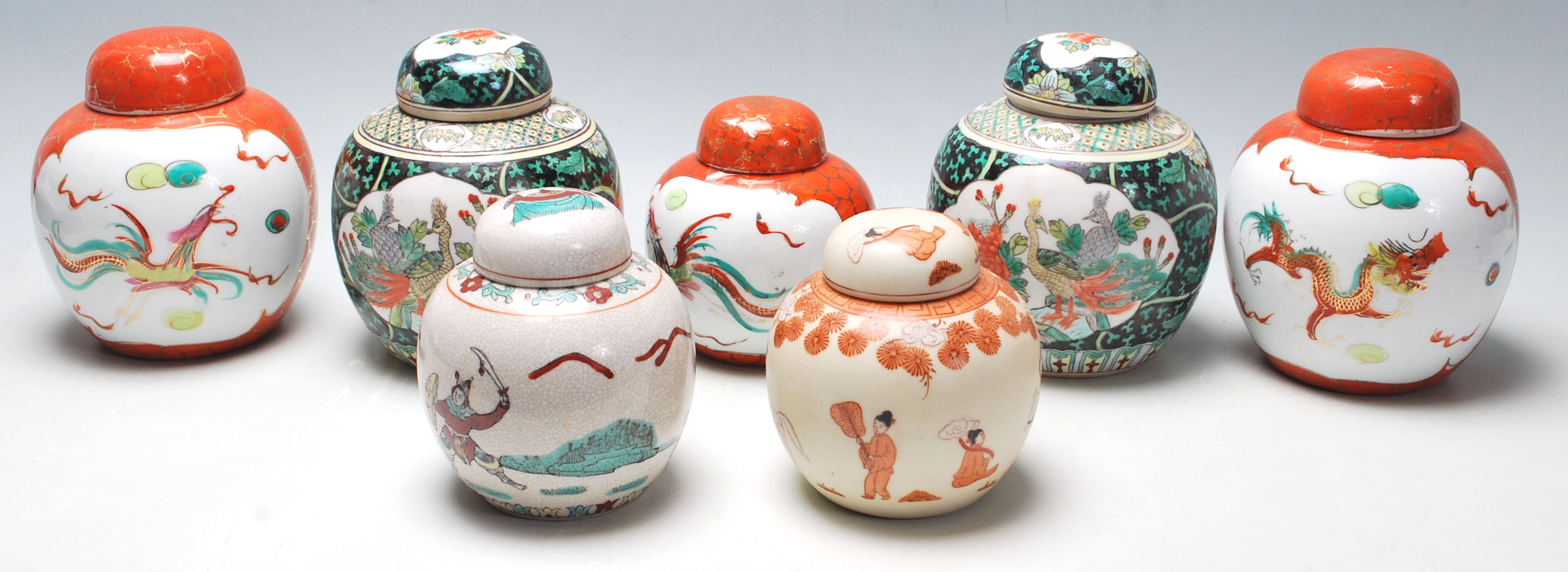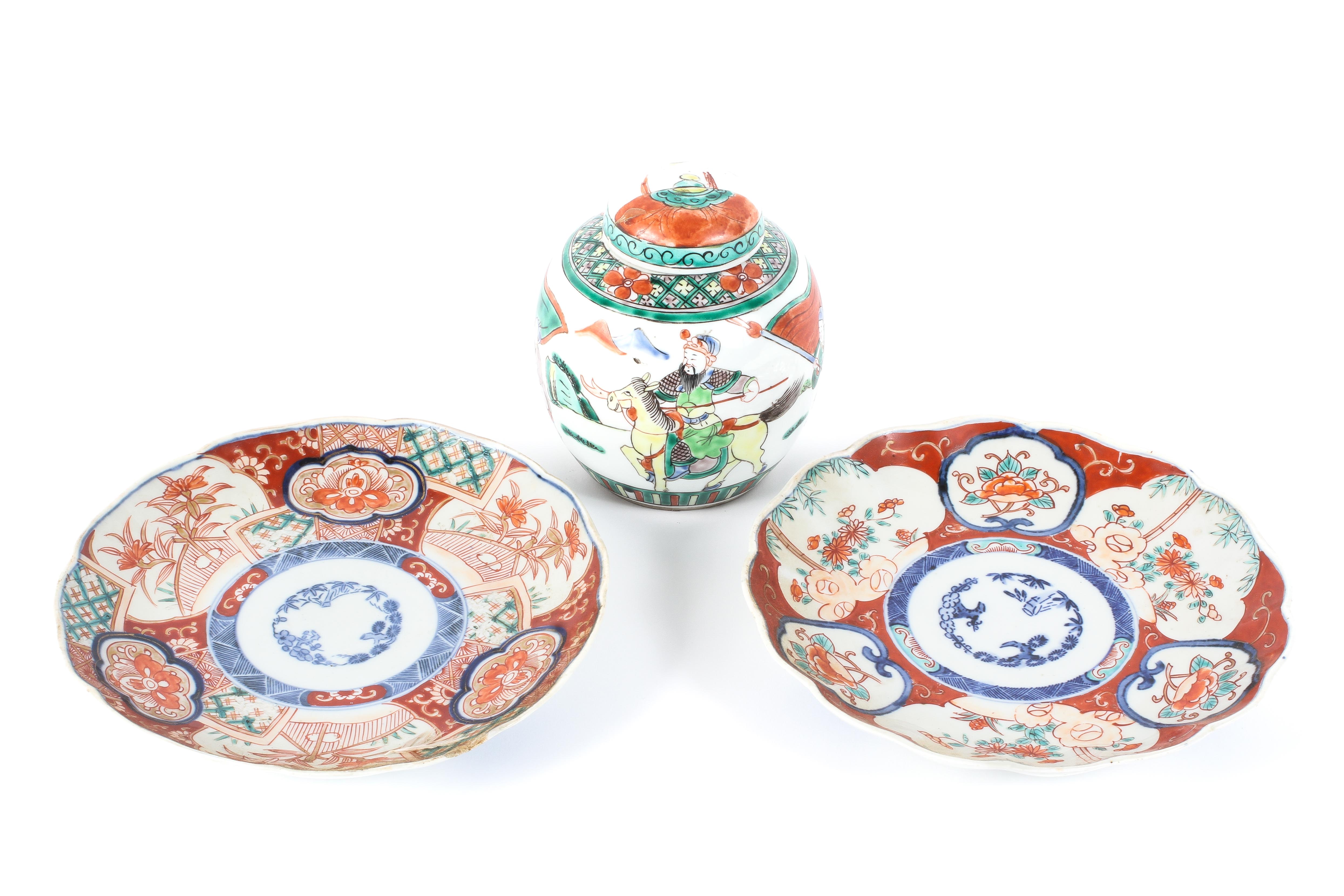清 綠彩荷塘清趣圖蓋罐(兩件) each similarly painted with a continuous lotus pond scene, with wooden stands (2) heights: 17.5cm and 19.5cm Provenance: Kimmerghame, Duns, the Estate of the Late Major General Sir John Swinton K.C.V.O., O.B.E., D.L. (1925-2018) Major General Sir John Swinton began his military career in 1944 with the Scots Guards, rising in rank to Major General in 1976. He was also Brigadier of the Queen’s Body Guard for Scotland (Royal Company of Archers) in 1977, and retired from Army life in 1979. With his strong military background, he was appointed Deputy Lieutenant for Berwickshire in 1980 and Lord Lieutenant from 1989 to 2000. A high point of his tenure was escorting the Stone of Scone back to Scotland in 1996. The Swinton family history and ownership of land in Berwickshire can be traced to the early part of the 12th century, when Ernulf de Swinton received one of the first private charters recorded in Scotland which confirmed his property from David I of Scotland (1084-1153). This is one of two original charters of David I kept in the cartulary of Durham; both are to Ernulf and also refer to Ernulf’s father (Udard), grandfather (Liulf) and great-grandfather (Eadulf) as holding the land before him. This would make Eadulf the first landowner of Scotland whose ownership could be proved, and means that the Swinton family would by this hypothesis be one of only three (the two others being the Arden and Berkeley families) that could trace its unbroken land ownership and lineage to before the Norman Conquest, making it one of the oldest landed families in Britain. Kimmerghame itself was the site of an earlier house, the home of Sir Andrew Home in the 1730s. The lands and estate of Kimmerghame came into the ownership of the family of Swinton in 1776 when Archibald Swinton of Manderston married Henrietta Campbell of Blythswood in Glasgow. This older house was demolished and rebuilt in the early 1850s, the architect being the celebrated David Bryce who employed some materials from the older house. Bryce’s Scots Baronial house was substantially damaged by fire in 1938 and only partially rebuilt. The family still retains Kimmerghame and its contents. Captain Archibald Swinton (1731-1804) went to India in the service of the East India Company as a surgeon. He reached Madras in 1752 and took part in the campaigns being waged between the French and English Companies for supremacy in the south. He also took part in an expedition 1756-57 to Negrais in Burma. He reached eastern India for the first time in 1759 when he arrived at Ganjam in Orissa and from there went on to Calcutta. He also transferred from being a surgeon to an ensignship in the Company’s Bengal army. When Archibald Swinton left the Company’s service at the end of 1765, he took with him a letter from the Emperor to King George III asking for help to reseat him on the throne of his ancestors, since Clive would not do so unilaterally; Swinton took a munshi with him in case the answer should be written in Persian. So ‘Captain Swinton, bringing with him the Munshy (sic) (and including in his baggage the large Indian jars, the Indian pictures, Chinese pictures painted on glass, numberless ivory, silver and crystal handled arms, jewels, Persian books, etc. etc.), sailed from India …’ The important group of Indian paintings and other works of art are now in the care of the National Museum of Scotland having been accepted by the nation in lieu of inheritance tax. The Swinton family have had strong connections with the Army and the legal profession. Part of their impressive collection was sold at our saleroom in Five Centuries: Furniture, Paintings and Works of Art sale on 23 Feb 2022.
清 綠彩荷塘清趣圖蓋罐(兩件) each similarly painted with a continuous lotus pond scene, with wooden stands (2) heights: 17.5cm and 19.5cm Provenance: Kimmerghame, Duns, the Estate of the Late Major General Sir John Swinton K.C.V.O., O.B.E., D.L. (1925-2018) Major General Sir John Swinton began his military career in 1944 with the Scots Guards, rising in rank to Major General in 1976. He was also Brigadier of the Queen’s Body Guard for Scotland (Royal Company of Archers) in 1977, and retired from Army life in 1979. With his strong military background, he was appointed Deputy Lieutenant for Berwickshire in 1980 and Lord Lieutenant from 1989 to 2000. A high point of his tenure was escorting the Stone of Scone back to Scotland in 1996. The Swinton family history and ownership of land in Berwickshire can be traced to the early part of the 12th century, when Ernulf de Swinton received one of the first private charters recorded in Scotland which confirmed his property from David I of Scotland (1084-1153). This is one of two original charters of David I kept in the cartulary of Durham; both are to Ernulf and also refer to Ernulf’s father (Udard), grandfather (Liulf) and great-grandfather (Eadulf) as holding the land before him. This would make Eadulf the first landowner of Scotland whose ownership could be proved, and means that the Swinton family would by this hypothesis be one of only three (the two others being the Arden and Berkeley families) that could trace its unbroken land ownership and lineage to before the Norman Conquest, making it one of the oldest landed families in Britain. Kimmerghame itself was the site of an earlier house, the home of Sir Andrew Home in the 1730s. The lands and estate of Kimmerghame came into the ownership of the family of Swinton in 1776 when Archibald Swinton of Manderston married Henrietta Campbell of Blythswood in Glasgow. This older house was demolished and rebuilt in the early 1850s, the architect being the celebrated David Bryce who employed some materials from the older house. Bryce’s Scots Baronial house was substantially damaged by fire in 1938 and only partially rebuilt. The family still retains Kimmerghame and its contents. Captain Archibald Swinton (1731-1804) went to India in the service of the East India Company as a surgeon. He reached Madras in 1752 and took part in the campaigns being waged between the French and English Companies for supremacy in the south. He also took part in an expedition 1756-57 to Negrais in Burma. He reached eastern India for the first time in 1759 when he arrived at Ganjam in Orissa and from there went on to Calcutta. He also transferred from being a surgeon to an ensignship in the Company’s Bengal army. When Archibald Swinton left the Company’s service at the end of 1765, he took with him a letter from the Emperor to King George III asking for help to reseat him on the throne of his ancestors, since Clive would not do so unilaterally; Swinton took a munshi with him in case the answer should be written in Persian. So ‘Captain Swinton, bringing with him the Munshy (sic) (and including in his baggage the large Indian jars, the Indian pictures, Chinese pictures painted on glass, numberless ivory, silver and crystal handled arms, jewels, Persian books, etc. etc.), sailed from India …’ The important group of Indian paintings and other works of art are now in the care of the National Museum of Scotland having been accepted by the nation in lieu of inheritance tax. The Swinton family have had strong connections with the Army and the legal profession. Part of their impressive collection was sold at our saleroom in Five Centuries: Furniture, Paintings and Works of Art sale on 23 Feb 2022.














Testen Sie LotSearch und seine Premium-Features 7 Tage - ohne Kosten!
Lassen Sie sich automatisch über neue Objekte in kommenden Auktionen benachrichtigen.
Suchauftrag anlegen